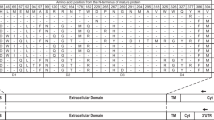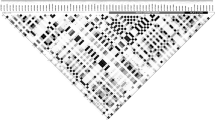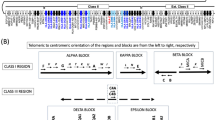Abstract
The KIR2DS3 gene is an activating homologue of the inhibitory killer-cell immunoglobulin-like receptors (KIR) that recognize HLA-C molecules, enabling NK cells to survey the normal function of endogenous antigen presentation. The genetics of KIR2DS3 is complicated by the existence of alleles with similar coding sequences that map to different regions of the KIR complex in chromosome 19, or whose location in this complex is unknown. Here, by studying the family segregation of the KIR alleles 2DS3*001, *002 and *003N, and the distribution of these in unrelated individuals, we demonstrate the existence of two paralogous KIR2DS3 genes that can be inherited separately or, as it happens frequently in Caucasoids due to linkage disequilibrium, together. Each KIR2DS3 gene is almost invariably associated in its 5′ end to a different copy of KIR2DL5, a gene previously shown to be duplicated in humans. KIR2DL5 and KIR2DS3 thus form two highly homologous gene clusters situated in the centromeric and the telomeric intervals of KIR haplotypes. Recombination between those clusters is the likely origin of new haplotypes, characterized in this study, which harbour further duplications or deletions of multiple KIR genes. Our results help understand the genetics of KIR2DS3 and the diversity of human KIR genotypes.
This is a preview of subscription content, access via your institution
Access options
Subscribe to this journal
Receive 6 digital issues and online access to articles
$119.00 per year
only $19.83 per issue
Buy this article
- Purchase on Springer Link
- Instant access to full article PDF
Prices may be subject to local taxes which are calculated during checkout





Similar content being viewed by others
Abbreviations
- KIR:
-
killer-cell Ig-like receptor
- LD:
-
linkage disequilibrium
- SSOP:
-
sequence-specific oligonucleotide probe
- SSP:
-
sequence-specific primer
References
Wilson MJ, Torkar M, Haude A, Milne S, Jones T, Sheer D et al. Plasticity in the organization and sequences of human KIR/ILT gene families. Proc Natl Acad Sci USA 2000; 97: 4778–4783.
Martin AM, Freitas EM, Witt CS, Christiansen FT . The genomic organization and evolution of the natural killer immunoglobulin-like receptor (KIR) gene cluster. Immunogenetics 2000; 51: 268–280.
Colonna M, Samaridis J . Cloning of immunoglobulin-superfamily members associated with HLA-C and HLA-B recognition by human natural killer cells. Science 1995; 268: 405–408.
Wagtmann N, Biassoni R, Cantoni C, Verdiani S, Malnati MS, Vitale M et al. Molecular clones of the p58 NK cell receptor reveal immunoglobulin-related molecules with diversity in both the extra- and intracellular domains. Immunity 1995; 2: 439–449.
Moretta L, Moretta A . Killer immunoglobulin-like receptors. Curr Opin Immunol 2004; 16: 626–633.
Vilches C, Parham P . KIR: Diverse, rapidly evolving receptors of innate and adaptive immunity. Annu Rev Immunol 2002; 20: 217–251.
Karre K . How to recognize a foreign submarine. Immunol Rev 1997; 155: 5–9.
Biassoni R, Cantoni C, Falco M, Verdiani S, Bottino C, Vitale M et al. The human leukocyte antigen (HLA)-C-specific ‘activatory’ or ‘inhibitory’ natural killer cell receptors display highly homologous extracellular domains but differ in their transmembrane and intracytoplasmic portions. J Exp Med 1996; 183: 645–650.
Biassoni R, Pessino A, Malaspina A, Cantoni C, Bottino C, Sivori S et al. Role of amino acid position 70 in the binding affinity of p50.1 and p58.1 receptors for HLA-Cw4 molecules. Eur J Immunol 1997; 27: 3095–3099.
Winter CC, Gumperz JE, Parham P, Long EO, Wagtmann N . Direct binding and functional transfer of NK cell inhibitory receptors reveal novel patterns of HLA-C allotype recognition. J Immunol 1998; 161: 571–577.
Dohring C, Samaridis J, Colonna M . Alternatively spliced forms of human killer inhibitory receptors. Immunogenetics 1996; 44: 227–230.
Norman PJ, Abi-Rached L, Gendzekhadze K, Korbel D, Gleimer M, Rowley D et al. Unusual selection on the KIR3DL1/S1 natural killer cell receptor in Africans. Nat Genet 2007; 39: 1092–1099; e-pub 12 Aug 2007.
Marsh SG, Parham P, Dupont B, Geraghty DE, Trowsdale J, Middleton D et al. Killer-cell immunoglobulin-like receptor (KIR) nomenclature report, 2002. Tissue Antigens 2003; 62: 79–86.
Uhrberg M, Valiante NM, Shum BP, Shilling HG, Lienert-Weidenbach K, Corliss B et al. Human diversity in killer cell inhibitory receptor genes. Immunity 1997; 7: 753–763.
Middleton D, Meenagh A, Moscoso J, Arnaiz-Villena A . Killer immunoglobulin receptor gene and allele frequencies in Caucasoid, Oriental and Black populations from different continents. Tissue Antigens 2008; 71: 105–113.
Middleton D, Meenagh A, Gourraud PA . KIR haplotype content at the allele level in 77 Northern Irish families. Immunogenetics 2007; 59: 145–158.
Robinson J, Waller MJ, Fail SC, Marsh SG . The IMGT/HLA and IPD databases. Hum Mutat 2006; 27: 1192–1199.
Valiante NM, Uhrberg M, Shilling HG, Lienert-Weidenbach K, Arnett KL, D'Andrea A et al. Functionally and structurally distinct NK cell receptor repertoires in the peripheral blood of two human donors. Immunity 1997; 7: 739–751.
Yawata M, Yawata N, Draghi M, Little AM, Partheniou F, Parham P . Roles for HLA and KIR polymorphisms in natural killer cell repertoire selection and modulation of effector function. J Exp Med 2006; 203: 633–645.
Luo L, Du Z, Sharma SK, Cullen R, Spellman S, Reed EF et al. Chain-terminating natural mutations affect the function of activating KIR receptors 3DS1 and 2DS3. Immunogenetics 2007; 59: 779–792.
Gómez-Lozano N, Gardiner CM, Parham P, Vilches C . Some human KIR haplotypes contain two KIR2DL5 genes: KIR2DL5A and KIR2DL5B. Immunogenetics 2002; 54: 314–319.
Hsu KC, Chida S, Geraghty DE, Dupont B . The killer cell immunoglobulin-like receptor (KIR) genomic region: gene-order, haplotypes and allelic polymorphism. Immunol Rev 2002; 190: 40–52.
Carrington M, Norman P . The KIR Gene Cluster. National Library of Medicine, National Center for Biotechnology Information: Bethesda, MD, 2003.
Gómez-Lozano N, Trompeter HI, de Pablo R, Estefanía E, Uhrberg M, Vilches C . Epigenetic silencing of potentially functional KIR2DL5 alleles: implications for the acquisition of KIR repertoires by NK cells. Eur J Immunol 2007; 37: 1954–1965.
Vilches C, Castaño J, Gómez-Lozano N, Estefanía E . Facilitation of KIR genotyping by a PCR-SSP method that amplifies short DNA fragments. Tissue Antigens 2007; 70: 415–422.
Middleton D, Curran M, Maxwell L . Natural killer cells and their receptors. Transpl Immunol 2002; 10: 147–164.
Keaney L, Williams F, Meenagh A, Sleator C, Middleton D . Investigation of killer cell immunoglobulin-like receptor gene diversity III. KIR2DL3. Tissue Antigens 2004; 64: 188–194.
Halfpenny IA, Middleton D, Barnett YA, Williams F . Investigation of killer cell immunoglobulin-like receptor gene diversity: IV. KIR3DL1/S1. Hum Immunol 2004; 65: 602–612.
Maxwell LD, Williams F, Gilmore P, Meenagh A, Middleton D . Investigation of killer cell immunoglobulin-like receptor gene diversity: II. KIR2DS4. Hum Immunol 2004; 65: 613–621.
Williams F, Meenagh A, Sleator C, Middleton D . Investigation of killer cell immunoglobulin-like receptor gene diversity: I. KIR2DL4. Hum Immunol 2004; 65: 31–38.
Gómez-Lozano N, Vilches C . Genotyping of human killer-cell immunoglobulin-like receptor genes by polymerase chain reaction with sequence-specific primers: an update. Tissue Antigens 2002; 59: 184–193.
Gómez-Lozano N, Estefanía E, Williams F, Halfpenny I, Middleton D, Solís R et al. The silent KIR3DP1 gene (CD158c) is transcribed and might encode a secreted receptor in a minority of humans, in whom the KIR3DP1, KIR2DL4 and KIR3DL1/KIR3DS1 genes are duplicated. Eur J Immunol 2005; 35: 16–24.
Garcia CA, Robinson J, Guethlein LA, Parham P, Madrigal JA, Marsh SG . Human KIR sequences 2003. Immunogenetics 2003; 55: 227–239.
Vilches C, Gardiner CM, Parham P . Gene structure and promoter variation of expressed and non-expressed variants of the KIR2DL5 gene. J Immunol 2000; 165: 6416–6421.
Acknowledgements
This work was supported by grant BFU2005–04622 from the Spanish Ministerio de Educación y Ciencia (to CV).
Author information
Authors and Affiliations
Corresponding author
Additional information
Conflict of interest
The authors have no financial or commercial conflicts of interest.
Supplementary Information accompanies the paper on Genes and Immunity website (http://www.nature.com/gene)
Supplementary information
Rights and permissions
About this article
Cite this article
Ordóñez, D., Meenagh, A., Gómez-Lozano, N. et al. Duplication, mutation and recombination of the human orphan gene KIR2DS3 contribute to the diversity of KIR haplotypes. Genes Immun 9, 431–437 (2008). https://doi.org/10.1038/gene.2008.34
Received:
Revised:
Accepted:
Published:
Issue Date:
DOI: https://doi.org/10.1038/gene.2008.34
Keywords
This article is cited by
-
KIR-HLA gene diversities and susceptibility to lung cancer
Scientific Reports (2022)
-
Comparative genetics of KIR haplotype diversity in humans and rhesus macaques: the balancing act
Immunogenetics (2022)
-
Genotype B of Killer Cell Immunoglobulin-Like Receptor is Related with Gastric Cancer Lesions
Scientific Reports (2018)
-
Recombinant structures expand and contract inter and intragenic diversification at the KIR locus
BMC Genomics (2013)
-
Conserved KIR allele-level haplotypes are altered by microvariation in individuals with European ancestry
Genes & Immunity (2012)



